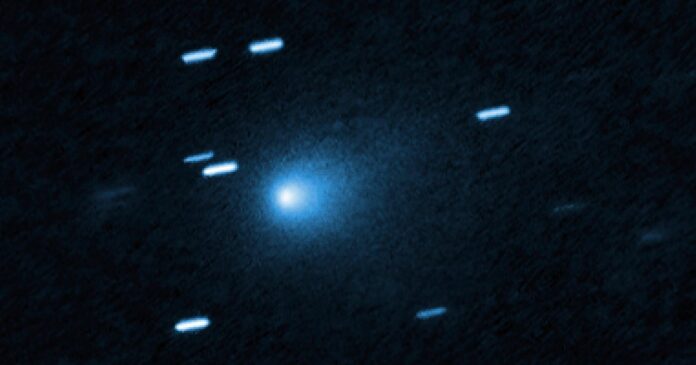The Hubble Space Telescope has captured the best picture yet of a high-speed comet visiting our solar system from another star.
NASA and the European Space Agency released the latest photos Thursday.
Discovered last month by a telescope in Chile, the comet known as 3I-Atlas is only the third known interstellar object to pass our way and poses no threat to Earth.
/ AP
Astronomers originally estimated the size of its icy core at several miles across, but Hubble’s observations have narrowed it down to no more than 3.5 miles. It could even be as small as 1,000 feet, scientists say, according to a new paper published in the Astrophysical Journal Letters.
The comet is hurtling our way at 130,000 mph, but will veer closer to Mars than Earth, keeping a safe distance from both. It was 277 million miles away when photographed by Hubble a couple weeks ago. The orbiting telescope revealed a teardrop-shaped plume of dust around the nucleus as well as traces of a dusty tail.
NASA previously said the comet will make its closest approach to the sun in late October, scooting between the orbits of Mars and Earth. The agency said 3I/ATLAS should remain visible to telescopes through September, but then it will pass too close to the sun to observe. It is expected to reappear on the other side of the sun by early December, allowing for renewed observations.
According to Las Cumbres Observatory in Chile, the object is named “3I” because it is the third such interstellar object to be found, following 1I/’Oumuamu in 2017 and 2I/Borisov in 2019.
“All three appear to be quite dark and red, reflecting only about 5% of the sunlight that hits them, which is similar in reflectivity to asphalt,” the observatory said last month. “Unlike 1I/’Oumuamu, 3I does not change much in brightness as it rotates, indicating that it is more likely to be spherical.”
Los Cumbres Observatory created an animation of image data from its telescope as it tracked the new interstellar on July 4, 2025:

